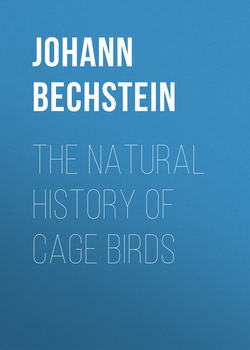Читать книгу The Natural History of Cage Birds - Bechstein Johann Matthäus - Страница 22
PIES
THE MAGPIE
ОглавлениеCorvus Pica, Linnæus; La Pie, Buffon; Die Elster, Bechstein
As the magpie generally frequents places near the abode of man, it is well known. It is eighteen inches in length, of which the tail alone measures ten. It may be called a handsome bird, although its plumage is only black and white, for these colours are perfect in their kind, and the tail, near the end, shines with a purple tint, gradually shading into steel blue.
Habitation. – The magpie builds its nest on trees which are near towns and villages; its eggs are pale green, speckled with grey and brown. In autumn the young ones assemble together in small parties.
Food. – When wild, the magpie lives on worms, insects, fruits, or roots, and sometimes eats eggs and young birds in their nest.
In the house, it likes bread, meat, and anything that comes from table; in short, when once tamed it does not fail to enter by the window at meal times to take its share. If it obtain too much, it hides what it does not eat for another time. This propensity is seen in young ones as soon as they can feed alone.
Peculiar Qualities. – Although in its wild state the magpie is so suspicious that it is difficult to catch it, it is, however, more easily tamed than any other bird; it will let itself be touched and taken in the hand, which even the most docile of other birds will seldom suffer. When reared from the nest it learns to speak even better than the raven, and becomes as domestic as the pigeon. It gets so fond of raw meat, bread, and other refuse of the table, that it does not wish any other food; this is the cause of its frequenting dwelling-houses: if it find any worms or insects it only eats them as dainties.
The time of taking magpies in order to bring them to this point is fourteen or fifteen days after coming out of the shell: this is the principal thing to remember with respect to any bird which is to be taught to go and come. It must be given at first bread soaked in milk or water; by degrees a little chopped meat is added, afterwards it will eat anything from the kitchen, even apples and baked pears, and any refuse. As soon as the young birds begin to fly high enough to rise to a neighbouring tree they may be let do so when they have had a good meal, soon calling them back again to the place fixed for their habitation; this practice may be repeated till they have all their feathers, and can fly well, when some of their wing-feathers must be cut, till the winter, a season in which they may be pulled out. Whilst the feathers are growing again, they become so well accustomed to the house and their master that they may be let go for several hours together without any danger of their wandering or not returning. If they speak they will only be the more agreeable.
Old magpies, which may easily be taken in winter with lime-twigs placed near some bits of meat, can be taught to remain in the yard by keeping the wings cut till the following autumn, when they may be let grow; from this time there is no fear of their not coming with the poultry, and in spring they will not fail to build near the house, and seek food for their young in the kitchen. I must repeat again that nothing shining must be left in the way of these birds, as they will carry it off immediately, and hide it with great care, let them have as much food as they like besides.
I have lately received a letter from one of my friends, in which he expresses himself thus: – “I have reared a magpie which comes like a cat to rub itself against me until I caress it. It has learnt of itself to fly into the country and return. It follows me everywhere, even for more than a league, so that I have much trouble to rid myself of it, and when I do not wish its company in my walks and visits I am obliged to shut it up: though wild with any other person, it marks in my eyes the least change in my temper. It will sometimes fly to a great distance with other magpies, without however connecting itself with them.”
